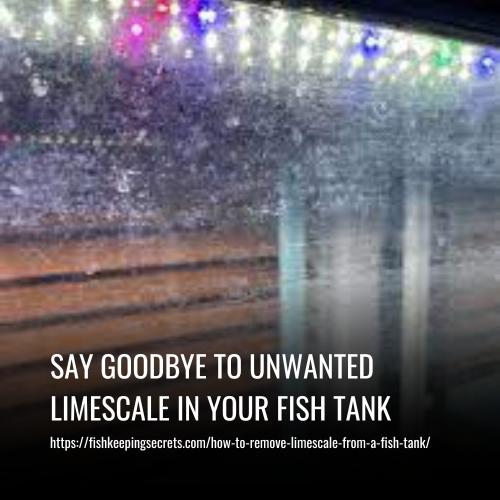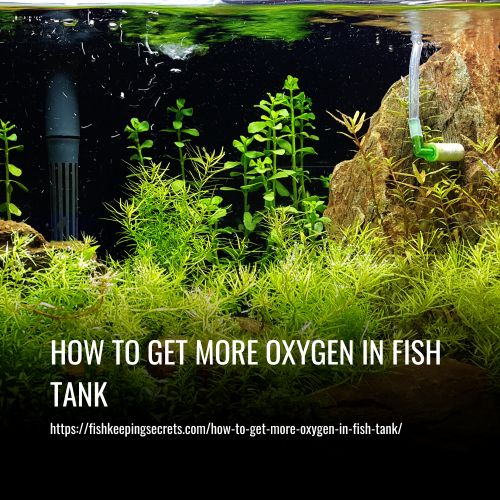To remove limescale from a fish tank, mix equal parts of water and white vinegar, pour onto the affected area, and let it sit for several minutes before scrubbing it off. Keeping a fish tank clean is a crucial aspect of maintaining a healthy and happy environment for your fish.
Limescale buildup on fish tanks can be an unsightly and potentially harmful problem, as it can affect the water quality and disturb the natural balance of the tank. While there are many commercial products available, they can be expensive and harmful to fish.
The most effective and affordable way to remove limescale buildup from a fish tank is by using white vinegar and water. This method is simple, quick, and easy to do at home, using tools and materials that are readily available. In this article, we will discuss the best way to remove limescale from your fish tank and how to prevent it from occurring in the future.

Understanding Limescale Buildup In Fish Tanks
Fish tanks are not just a decorative item for your home, they require regular maintenance to keep your aquatic pets healthy and happy. One of the issues that might arise is the buildup of limescale, also known as calcium deposits, on the walls and other surfaces of the tank.
Here’s what you need to know about limescale buildup in fish tanks:
What Is Limescale And How Does It Form In A Fish Tank?
Limescale is a white, chalky residue that forms when hard water evaporates, leaving behind high levels of calcium and other minerals on surfaces. In a fish tank, limescale buildup occurs due to the evaporation of water, which leaves behind calcium deposits on the walls, substrate, and other surfaces in the tank.
Here are some key points to remember:
- Limescale buildup can occur in both freshwater and saltwater aquariums.
- The hardness of the water determines the severity of limescale formation.
- Aquariums located in areas with hard water are more susceptible to limescale buildup.
Why Is Limescale Buildup Harmful To Your Fish And Aquatic Plants?
Limescale buildup can negatively impact the health of your fish and plants. Here are a few reasons why:
- Limescale buildup can cause blockages in filters and pumps, leading to a decrease in water circulation and reduced oxygen levels for your fish.
- The rough surface of limescale can scratch and irritate the skin of your fish.
- Limescale buildup can coat the leaves of aquatic plants, preventing them from carrying out photosynthesis and ultimately causing them to die.
Here are some key points to remember:
- The build-up of limescale can result in a decrease in the water quality of your aquarium.
- High levels of limescale can lead to an increase in pH levels, which can be harmful to sensitive fish and plants.
- Your fish tank should be cleaned regularly to avoid limescale buildup.
Identifying The Signs Of Limescale Buildup In Your Aquarium
It’s important to identify the signs of limescale buildup in your aquarium early to prevent any damage to your fish and plants. Here are some signs to look out for:
- White, crusty deposits on the walls and other surfaces of the tank.
- Reduced water flow from the filter and pump.
- An increase in pH levels.
Here are some key points to remember:
- Limescale buildup can easily be removed if identified early.
- Regular maintenance of your aquarium can help prevent limescale buildup.
- Water hardness tests can be carried out to monitor levels of limescale buildup in your aquarium.
Preventing Limescale Buildup In Your Fish Tank
Preventing limescale buildup in your fish tank is essential for maintaining a healthy environment for your aquatic pets. Here are some tips to help prevent limescale buildup:
Water Hardness And Its Impact On Limescale Buildup:
Understanding the hardness of your fish tank water is essential in preventing limescale formation. Hard water contains high levels of calcium and magnesium that can result in scaling. Here are some key points to keep in mind:
- The hardness of water is measured in degrees of general hardness (gh), so it is crucial to test it regularly and maintain the appropriate levels for your fish species.
- Maintain gh levels by adding deionized water, reverse osmosis (ro) water, or distilled water to freshen up your tank and lower gh levels.
- Ensure that your aquarium décor free from calcium buildup, as they can accelerate the formulation of limescale.
Temperature And Its Role In Limescale Formation:
Temperature holds a significant role in the formation of limescale in a fish tank. Here are some key points to remember to keep the limescale away:
- When the temperature of the water is high, the chance of limescale formation is greater. Keep the water temperature optimal for your fish species to prevent limescale formation.
- Ensure that the heating system you use is appropriate for the size of your aquarium. An oversized heater can heat the water too much and cause limescale to form.
- Avoid placing your fish tank near heat sources or direct sunlight to avoid overheating the water.
Choosing The Right Filtration System To Prevent Limescale
Keeping your filter system clean and effective plays an important role in preventing limescale formation. Here are some key points to consider while choosing the right filtration system for your fish tank:
- Installing a filtration system that utilizes deionization or reverse osmosis is an excellent way to remove the minerals in the water that can cause limescale buildup.
- Choose a filter that fits your tank size and the type of fish you have. A good rule of thumb is to have a filter that can handle twice the amount of your tank’s water capacity.
- Maintain the filter properly by cleaning it once a month to prevent limescale buildup from occurring.
Regular Water Changes As A Key Prevention Technique
Regular water changes are vital in preventing limescale formation in your fish tank. Here are some key points to keep in mind:
- Algae growth can lead to increased limescale formation, and regular water changes can help to regulate the nutrient levels that encourage this growth.
- Replace around 20% of the water in your tank every two to three weeks to ensure that fresh water is always available.
- Use a siphoning method to remove any debris settling at the bottom of your tank during water changes, so it does not contribute to limescale buildup.
Removing Limescale From Your Fish Tank
Keeping your fish tank clean and healthy is essential to ensure your fish thrive in their habitat. Limescale buildup can quickly accumulate on the tank’s surface, equipment, and decorations, making it challenging to maintain the tank’s cleanliness. Limescale buildup can lead to the growth of harmful bacteria and reduce the tank’s aesthetic appeal.
We explore several ways to remove limescale from your fish tank.
Manual Removal Techniques: Scraping, Scrubbing, And Chiseling
One of the easiest ways to remove limescale from your fish tank is through manual techniques such as scraping, scrubbing, and chiseling. These techniques are useful for removing stubborn limescale buildup that cannot be removed using traditional cleaning methods. Here are some ways to do it:
- Scraping: Use a plastic scraper to remove the limescale. Gently scrape the limescale and ensure not to damage the tank’s surface. You can use a soft-bristled toothbrush to remove limescale on the tank’s crevices.
- Scrubbing: Use a non-abrasive cloth or sponge and dip it in vinegar or lemon juice. Rub it on the limescale area for some time before rinsing it off with fresh water.
- Chiseling: Use a chisel or a putty knife to carefully remove the limescale. Take care not to scratch the glass.
Chemical Solutions: Natural And Synthetic Options
If manual removal fails, you can opt for chemical solutions to remove limescale. There are two options to consider – natural and synthetic:
- Natural solutions: White vinegar and lemon juice are natural solutions that work well in removing limescale. Soak the affected area with the solution for a few hours before rinsing it off with fresh water.
- Synthetic solutions: There are many synthetic solutions available in pet stores that can effectively remove limescale. Always follow the instructions on the label to avoid harming your fish or damaging the tank’s surface.
Using Household Items To Remove Limescale Buildup
If you don’t want to use chemicals or manual techniques, you can use everyday household items to remove limescale buildup. Here are some items you can use:
- Baking soda and water: Mix baking soda and water to form a paste and apply it to the limescale areas. Leave it to sit for some time before rinsing it off.
- Toothpaste: Squeeze toothpaste on a soft-bristled toothbrush and scrub the limescale area gently before rinsing it off with fresh water.
- Salt and vinegar: Mix salt and vinegar into a paste and apply it to the limescale buildup. Leave it to sit for some time before scrubbing it off and rinsing it with fresh water.
Now that you know the different techniques to remove limescale from your fish tank, ensure to keep your tank clean and healthy for your fish. A clean and healthy environment promotes better growth and longevity for your fish.
Maintaining A Clean And Healthy Fish Tank
Regular cleaning and maintenance of your fish tank are essential to keep your fish healthy and happy. But cleaning a fish tank can be a daunting task for beginners. In this section, we will discuss the importance of regular tank cleaning and maintenance, tips to keep your aquarium free of limescale and other harmful elements, and common mistakes to avoid when caring for your fish tank.
The Importance Of Regular Tank Cleaning And Maintenance
Regular cleaning and maintenance of your fish tank are critical for the health of your fish and the overall wellbeing of your aquarium. Here are some key reasons why you should make regular tank cleaning and maintenance a part of your routine:
- Regular cleaning helps to remove harmful elements like toxins, ammonia, and nitrates that can build up over time and harm your fish.
- Cleaning helps to maintain water clarity, ensuring that your fish have a healthy and clean environment to live in.
- Regular maintenance helps to prevent limescale and other mineral deposits from forming, which can lead to damage to your tank equipment and make it harder to maintain optimal water quality.
- Regular cleaning and maintenance make it easier to detect and address any issues with your aquarium before they become major problems.
Tips To Keep Your Aquarium Free Of Limescale And Other Harmful Elements
Limescale is a common problem in fish tanks, especially if you live in an area with hard water. Here are some tips to help you keep your aquarium free of limescale and other harmful elements:
- Use a good quality water conditioner when you add water to your tank. This will help to remove any harmful chemicals and minerals from the water, making it safer for your fish and preventing mineral build-up in your tank.
- Clean your tank regularly to prevent limescale build-up. Use a soft-bristled brush to gently scrub away any deposits on the glass, decorations, and equipment in your tank. Avoid using harsh chemicals or abrasives, as these can damage your tank and harm your fish.
- Monitor the pH and hardness levels of your water and adjust them as needed. Ph levels should be kept between 6.5 and 7.5, and hardness levels should be kept between 100 and 200 ppm.
- Make sure the water is well-oxygenated, as this can help to prevent the build-up of harmful toxins in your tank. You can do this by adding an air stone or bubble wand to your aquarium.
- Change the water in your tank regularly, ideally once a week. This will help to remove any toxins or harmful elements that have accumulated in the water over time.
Common Mistakes To Avoid When Caring For Your Fish Tank
Even the most experienced fish owners can make mistakes when caring for their aquariums. Here are some common mistakes to avoid:
- Overfeeding your fish: Overfeeding can lead to excess waste and toxins in your tank, harming your fish and leading to poor water quality.
- Overstocking your tank: Overstocking your tank can also lead to poor water quality, as too many fish produce too much waste for the tank to handle.
- Neglecting to maintain your filter: Your filter is essential for maintaining optimal water quality in your tank. Neglecting it can lead to harmful toxins and waste accumulating in the water.
- Using tap water without treatment: Tap water often contains harmful chemicals and minerals that can harm your fish and lead to limescale build-up in your tank. Always use a water conditioner when adding tap water to your aquarium.
- Not cleaning your tank regularly: Regular cleaning is essential for maintaining optimal water quality and preventing limescale build-up. Neglecting to clean your tank regularly can lead to harmful toxins and mineral deposits harming your fish and equipment.
Final Thoughts On Limescale Buildup In Fish Tanks
Limescale buildup in fish tanks can be a frustrating and potentially harmful issue for both your fish and the overall health of your aquarium. However, with regular maintenance and proper care, it is entirely possible to prevent limescale from forming and keep your fish tank clean and healthy.
How Limescale Buildup Can Impact The Overall Health And Well-Being Of Your Fish
Limescale buildup in a fish tank can have dire consequences for the aquatic environment and the health of your fish. Here are a few ways in which limescale buildup can negatively impact your fish:
- Limescale can cause the water hardness to increase, making it difficult for your fish to regulate the amount of water they take in, leading to dehydration or even death.
- It can trap harmful bacteria and other toxins, preventing good bacteria from growing and creating a healthy, stable environment.
- Limescale buildup can also obstruct the filter and other equipment, reducing the overall efficiency and performance of the tank.
Preventing limescale buildup in your fish tank is crucial to keeping your fish healthy and happy.
The Importance Of Proactive Prevention And Regular Maintenance To Ensure A Healthy Aquatic Environment
Preventing limescale buildup in a fish tank isn’t complicated, but it does require regular maintenance and proactive prevention. Here are some tips to keep your aquarium free from limescale:
- Regularly test the water to maintain optimal ph and water hardness levels. Excessively hard water can lead to limescale buildup.
- Clean your tank often. Regular cleaning can prevent the buildup of limescale, as well as harmful bacteria and other toxins.
- Use water softeners. Water softeners can prevent the buildup of calcium and other minerals that contribute to limescale formation.
- Invest in a good water filter. A good water filter will keep your tank clean and help maintain optimal water conditions.
Proactive prevention and regular maintenance are essential to maintaining a healthy aquatic environment for your fish.
Saying Goodbye To Unwanted Limescale And Hello To A Thriving Fish Tank
Removing limescale buildup in your fish tank is a simple process. Here are some steps to follow:
- Turn off all equipment and pumps before beginning to clean.
- Using a scraper or scrubber, remove any visible buildup inside the tank.
- For more stubborn or hard-to-reach spots, you can mix one-part vinegar to four parts water and spray it onto the affected area. Let it sit for a few minutes before scrubbing it clean.
- Rinse thoroughly with water.
- Turn the equipment back on once the tank is clean.
FAQs
Limescale buildup appears as a white-grey film on the aquarium glass. If it persists even after cleaning, it is likely limescale.
Limescale buildup can cause ph and chemical imbalances in the water, which is dangerous to fish and other aquatic pets, and can also harm aquatic plants.
The best way to remove limescale is by using vinegar, lemon juice, or a commercial limescale remover. Use a non-abrasive sponge to scrub the glass.
Fish should be removed from the tank before cleaning with vinegar or commercial limescale remover. Water changes may suffice in mild cases.
Regular and frequent cleaning of the aquarium can prevent limescale buildup. It is best to stick to a clear schedule to keep the aquarium looking clean and healthy.
Besides regular cleaning, you can add a water softener or use a reverse osmosis filter to prevent limescale buildup. Avoid overfeeding your fish and test your water regularly.
Conclusion
As a fish tank owner, dealing with limescale can be quite frustrating. However, with the tips and tricks outlined in this article, you should have no trouble keeping your fish tank clean and free of limescale build-up. Remember to always use the right tools and to clean your tank regularly to prevent limescale from forming.
Furthermore, it’s essential to maintain your fish tank’s ph level by using the right water conditioner to ensure the health and happiness of your fish and plants. Lastly, creating a routine cleaning schedule will help you stay on top of limescale build-up and prevent it from becoming a significant problem.



